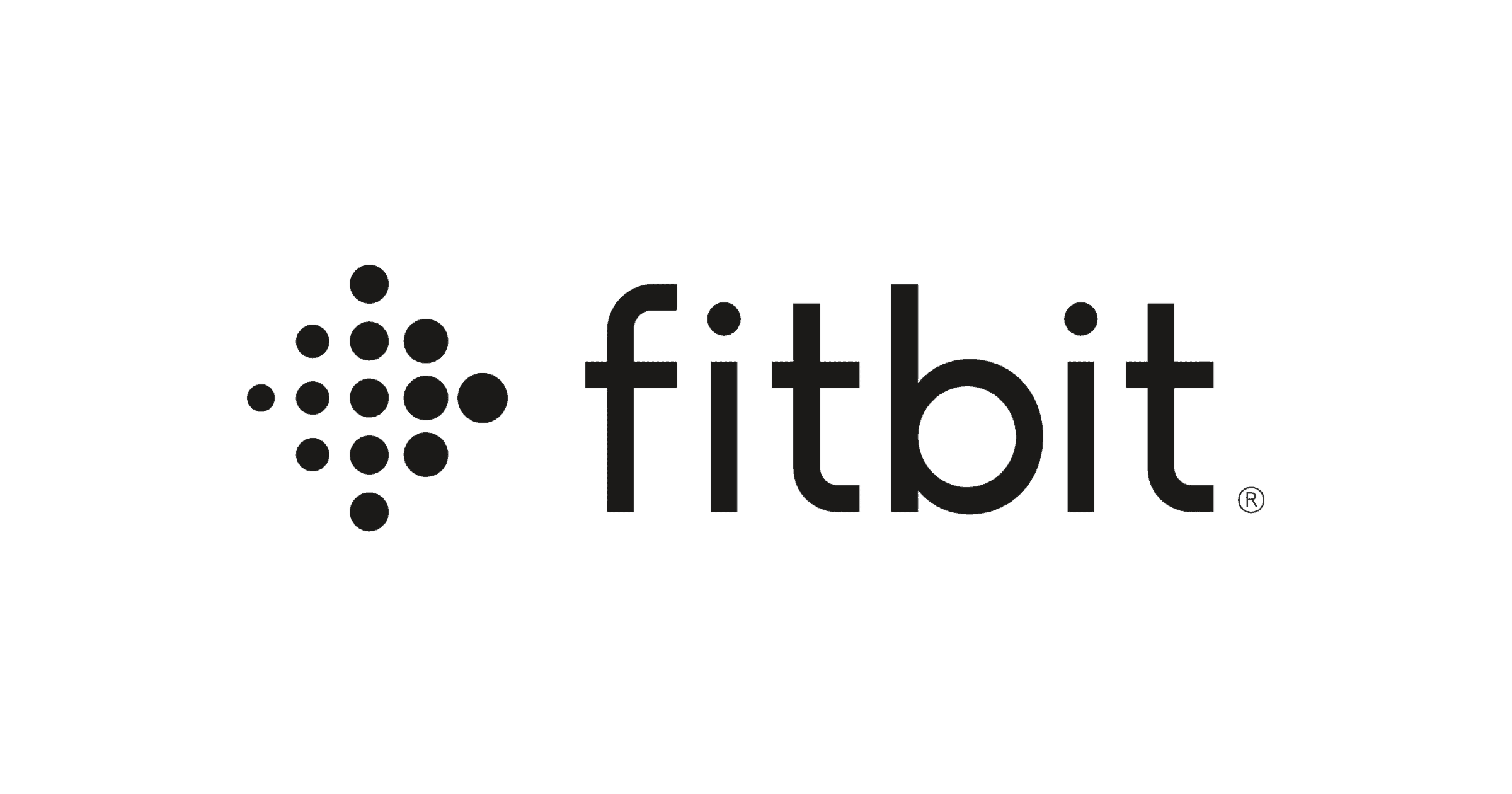Fitbit Review 2024
A Fitbit can help seniors stay in shape and keep track of their overall health.
SeniorLiving.org is supported by commissions from providers listed on our site. Read our Editorial Guidelines
SeniorLiving.org is supported by commissions from providers listed on our site. Read our Editorial Guidelines
What Is a Fitbit?
A Fitbit is a wearable fitness tracker sold by the consumer electronics company Fitbit Inc. While it’s common for mobile phones and other high-tech devices to track simple metrics such as the number of steps you’ve taken, some Fitbits monitor more sophisticated health data. For example, the Fitbits I tested can track oxygen saturation, the amount of oxygen-carrying hemoglobin in the blood relative to the amount of hemoglobin not carrying oxygen. Can your Timex do that? Some of their functions are so advanced that Fitbit products are currently being used in research studies to see if the data can help detect the early onset of infectious diseases like the flu and COVID-19.
If you think Fitbit is more suited to young athletes in training, think again. Fitbit is currently working with several health plans in the Medicare Advantage realm, including UnitedHealthcare, Humana, and Senior Care Action Network. Fitbit has also been included in wellness kits supporting senior health that have been distributed to Medicare recipients by some health plans.
After spending some time with two Fitbit models, I feel that the devices can inspire seniors to keep moving, get in better shape, lose weight, improve nutrition, reduce stress, and enjoy better sleep — all while keeping track of their overall health. A monthly subscription unlocks even more features to help users meet their goals.
Surprisingly, what impressed me the most wasn’t how Fitbits tracked my workouts so much as how they produced data when I was barely moving at all! Without further ado, let’s get into my hands-on review of Fitbit.

Testing out my Fitbit Sense smartwatch
Fitbit Product Line
Fitbit makes a wide range of products, from simple fitness trackers to sophisticated smartwatches. This review will focus on the two Fitbit models I tested: Charge 4, a fitness tracker with some smartwatch features, and the Sense smartwatch. Although some models won’t break the bank, Fitbit is not a bargain brand. Some of their best features require monthly subscriptions in addition to the equipment purchase price.
One other thing to keep in mind: Fitbit no longer sells the Charge 4 or the Sense on their website, as they’ve upgraded to the Charge 6 and the Sense 2. However, you can find the Charge 4 from other retailers like Best Buy or Amazon.
Pro Tip: If you’re in the market but price-sensitive, some models go on sale bundled with a limited-time Fitbit Premium subscription that usually costs $10 per month or $80 per year.
Below is a closer look at some of Fitbit’s popular product and services lineup, so you can decide which device is right for you and your goals.
Fitbit Smartwatches
| Model | Price | Best for | Feature highlights |
|---|---|---|---|
| Fitbit Sense | $249.95 | Seniors concerned with gaining better control of their overall stress levels, heart health, and fitness. |
|
| Fitbit Versa 4 | $199.95 | Active seniors who like to stay on top of their health specs, from sleep stats to breathing rate. |
|
| Fitbit Versa 3 | $299.95 | Seniors who want fitness motivation but don’t need EDA/ECG or skin-temp features. |
|
Fitbit Trackers
| Model | Price | Best for | Feature highlights |
|---|---|---|---|
| Fitbit Inspire 3 | $99.95 | Seniors needing a no-frills tracker who want to try Fitbit Premium risk-free. |
|
| Fitbit Luxe | $99.95 | Seniors who want a stylish tracker with mid-range features. |
|
| Fitbit Charge 5 | $149.95 | Active seniors who want a feature-rich, fitness-focused tracker with smartphone notification features. |
|
| Fitbit Charge 6 | $159.95 | Active seniors who want an all-in-one fitness tracker that offers smartphone features, including music, payment, and GPS apps. |
|
Fitbit has a variety of smartwatches and fitness trackers to help you stay on track and crush your health goals.
Fitbit Services and Miscellaneous Products
| Product | Price | Best for | Feature highlights |
|---|---|---|---|
| Fitbit Premium Membership | Free 90-day trial ($9.99 per month or $79.99 per year after) | Motivated seniors looking to improve and track their fitness. |
|
| Fitbit Aria Air Scale | $49.95 | Seniors looking to easily track weight goals/trends with the Fitbit app or membership. | Smart scale syncs to Fitbit to chart BMI and weight trends |
Unboxing My Fitbit Products
Instead of pretending that one size fits all wrists, Charge 4 and Sense each come boxed with a small and large silicone band, which is a nice touch. Sometimes, putting on the Fitbit felt comfortable. On other occasions, I felt like I had to adjust the band repeatedly to keep it from digging into my skin. Fitbit recommends wearing the watch tighter on your wrist during exercise than other times to improve its skin-facing sensors, but I didn’t find changing its position back and forth practical. The company also offers other watch bands and accessories, including a smart scale that can communicate with your Fitbit.
Besides the tracker itself, each Fitbit comes with a charger. While many consumer electronics share a charge port type, such as USB-C or Lightning (iOS), Fitbit devices use their own connections to power.
Pro Tip: Want to compare your options? Check out our list of the best smartwatches for seniors.
Many smartwatches can’t go 48 hours between charges, requiring users to plug them in overnight. I’ve struggled to connect another brand’s smartwatch to its power adapter, often waking up to find that my watch did not charge at all. It would prevent me from wearing it that day.
For both the Fitbits I tested, the charging connections were secure and easy to use right out of the box. Occasionally, the Charge 4 took a bit of fiddling to get seated just right. Luckily, both devices indicate when they are properly charging. Best of all, these watches can last multiple days without requiring a charge. The biggest “issue” was finding a time that I didn’t want to wear the device, since wearing and charging are mutually exclusive. If I walked the dog while charging the device, I’d miss counting a few thousand steps!
Setting Up My Fitbit Trackers
As one can imagine, giving commands to a watch by pressing buttons is quite limited, even for those whose hands are perfectly healthy. The Fitbits I tried didn’t even have a button in the traditional sense. Instead, they had a small section sensitive to touch that they call an “inductive button.”
You need a smartphone or computer to use a Fitbit, which connects to the device via Wi-Fi or Bluetooth. While the Charge 4 I tested took to Wi-Fi right away, Sense failed to hook up with multiple Wi-Fi networks repeatedly. However, after a system update, it finally connected to the network.
While it’s easy to get data for the day right on the Fitbit, your smartphone or computer can display massive amounts of past data, change watch faces, and do tons more than can be accomplished with a simple click or swipe.
Let’s Get Physical
Each of the Fitbits I tested contains a built-in Global Positioning System (GPS) and tracks simple metrics like daily steps, distance, calories burned, and floors climbed. Users can display some or all the daily totals on their customizable watch faces and easily change the targets to match their lifestyles.
Tracking Daily Metrics and Goals
My daily miles target was preset at 3.1 miles. When I ran every day, that was easy to achieve, but I came up short on days I didn’t work out. While exercising regularly, my weekly total exceeded 37 miles. My nightly dog walk was often interrupted by my Sense buzzing and displaying a visual reward acknowledging that I had accomplished five miles that day. Little touches like that can be inspirational for someone trying to stay fit.
When I didn’t exercise, the dog walks upped my weekly total to 21 miles, a far cry from more active weeks. Of course, your mileage will vary.
One unique metric that Fitbits track is called Active Zone Minutes. It’s calculated using your age and resting heart rate to provide you with a more personalized measurement of how hard you worked during any energizing activity beyond just steps. For me, I would clock an Active Zone Minute if my heartbeat was higher than 93 bpm and would get double credit when it was higher than 115. During a week when I ran every day, I logged over 550 Active Zone Minutes, but only 132 during a low-exercise week.
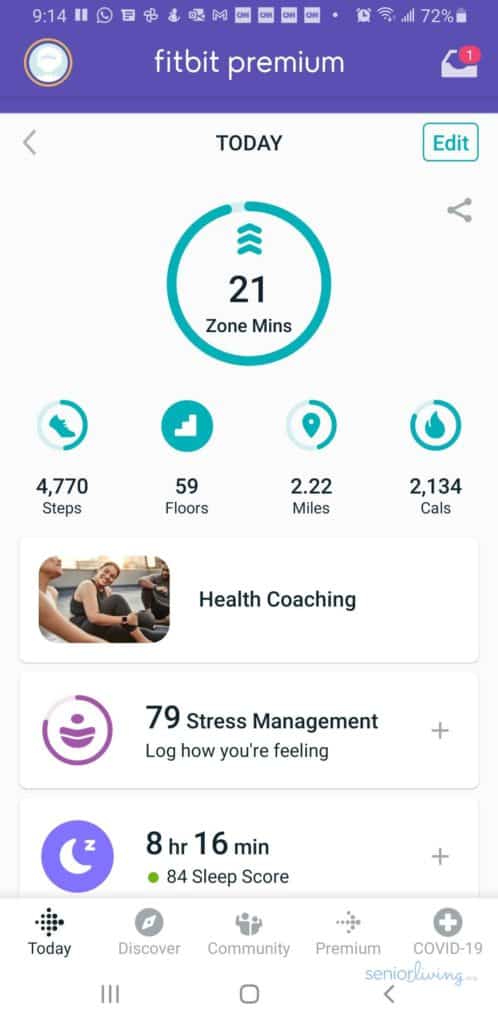
Taking a look at my daily Fitbit metrics and Active Zone Minutes
With these metrics popping up on my watch face throughout the day, aided by small vibrations giving reminders to move after being inactive for too long, it’s easy to see how a glance at the Fitbit motivates you to keep moving. It’s also fascinating to see these metrics displayed numerically and graphically on the app or website, including heartbeat tracking. Even though the watch face on the Charge 4 is smaller than the 1.5-inch, rounded, square-ish touchscreen of the Sense and more difficult to read in sunlight, the data is all large and easy to read on the phone or computer.
Did you know some studies have found that getting 7,000 steps a day could help you live longer? It’s easy to track your steps with a Fitbit. Check out my video below to learn more about getting in your daily steps!
Fitbit Tracking and Data Accuracy
So, just how accurate is Fitbit’s data? Regarding the Sense’s electrocardiogram (ECG) app, federal regulators gave their OK to its algorithm’s ability to accurately detect atrial fibrillation (AFib) from normal sinus rhythm.
On the other hand, since the Fitbit is usually worn on the wrist, a simple shake of the arm can cause the step counter to increase. I found that cooking could increase our step count a lot. Since those discrepancies tend to average out, I was fine relying on the metrics as an accurate relative measure of that day’s activity level. Even when I cooked multiple meals for my kids, I rarely hit my preset target of 10,000 steps in one day.
If anything, the data recorded was often lower because of missed steps and exercise when I wasn’t wearing the watch. The numbers may be rough, but you can still compare daily and weekly totals to each other despite these factors. In addition to the graphs and numeric displays, Fitbit would often surprise me via email with a badge, such as the Skydiver badge for climbing 1,000 floors since I started tracking, or the London Underground badge for covering 250 miles. I somehow earned a Skyscraper badge for climbing 117 floors in a single day spent in my two-story house without even working out.
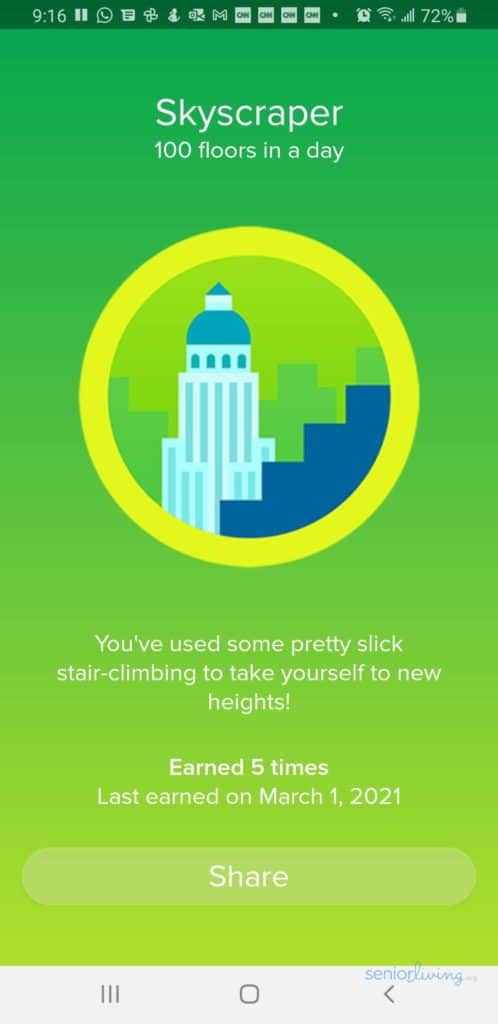
Earning my Fitbit Skyscraper badge
During exercise, things got a little tricky. Fitbits recognize exercise sessions and display data after the fact, but I wanted to see my time and distance while running. To do so, I had to select “Run” from a list, then press the button to Start, Resume, and Stop tracking the activity.
It was difficult to see what time it was mid-run, or sometimes to see the display at all without pressing the button again during a workout. I often accidentally stopped the monitoring while trying to see the data. On the other hand, after forgetting to start a workout on my Sense, it still accurately recorded that I spent 37 minutes on an elliptical machine. It was easy to see a map of where I rode my bike or ran, and all the data for that exercise after it was completed.
Rest and Relaxation
The most surprising features of the Fitbits are their ability to track your sleeping and help you relax. I had no problem wearing the Sense while sleeping, though others might. Even when I didn’t remember to set it to Sleep mode, it never disturbed me with an ill-timed message, as I set my phone to Do Not Disturb.
Tracking My Sleep
After a good night’s sleep – or a bad one – the Fitbit would display a Sleep Score and a breakdown of the time spent awake, as well as in REM, light, and deep sleep. Sense also records your skin temperature and your oxygen saturation, or SpO2. While lower data points in the latter may be a reason to consult a physician, the former, I imagine, could be impacted by my electric blanket setting.
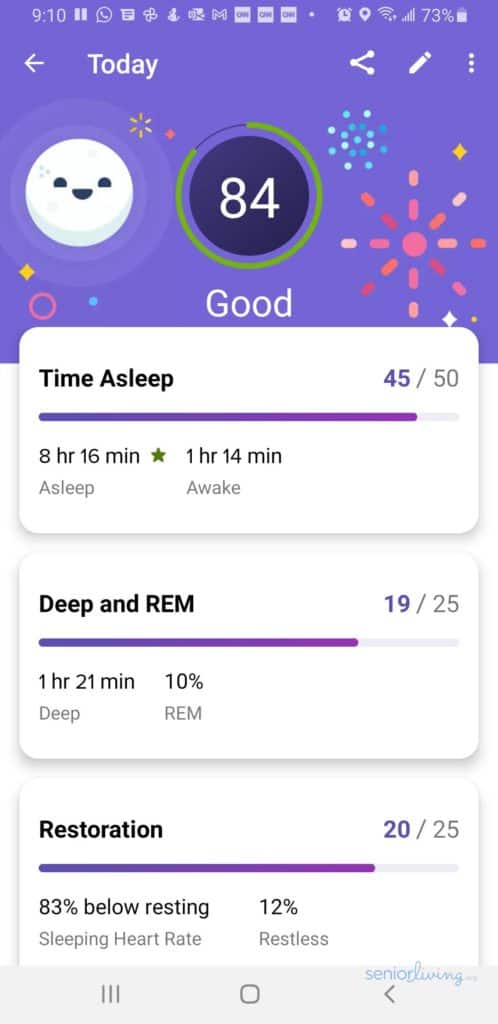
Taking a look at my Sleep Score in the Fitbit app
While Sense’s extra sleep data points did not add much to my experience, it was interesting to see the correlation between how well I slept and how I felt the next day. I admit to getting hooked on sleeping with the watch, to the point where the battery would occasionally die in the middle of the night, as I rarely removed it. Of course, after a quick charge, the watch would report an extremely short sleep, unaware that its battery had been cut short, not my rest itself.
Meditation and Relaxation
Besides sleep, I was surprised to learn how much Fitbit embraces meditation and mindfulness. While Charge 4 can guide you through a two-minute breathing exercise, the Sense has a built-in electrodermal (EDA) sensor that can help you meditate for an extended period and then display the results.
By putting your hand on top of the watch face, the Fitbit applies tiny electrical charges to your skin. This measures how the charges interact with your sweat, which may indicate your body’s response to stress.
Premium members can see their Stress Management Score, which combines a dozen different data points — including sleep, exercise, and heart rate variability — to produce a number from one to 100. Just as active users may want to see a higher number of steps recorded to help their physical activity, more sedentary seniors may track their Stress Management Score to achieve higher numbers and, presumably, inner peace.
Tracking my Stress Management Score in the Fitbit app
Some data points, like breathing rate and heart rate variability, are exclusive to Premium members. Members also enjoy personalized recommendations based on their data, workouts, games and challenges, guided programs, advanced sleep analytics, and mindfulness and meditation videos from the world-renowned Deepak Chopra. The more you put into self-logging on Premium, such as recording your water and food intake, the more you’ll get out of it.
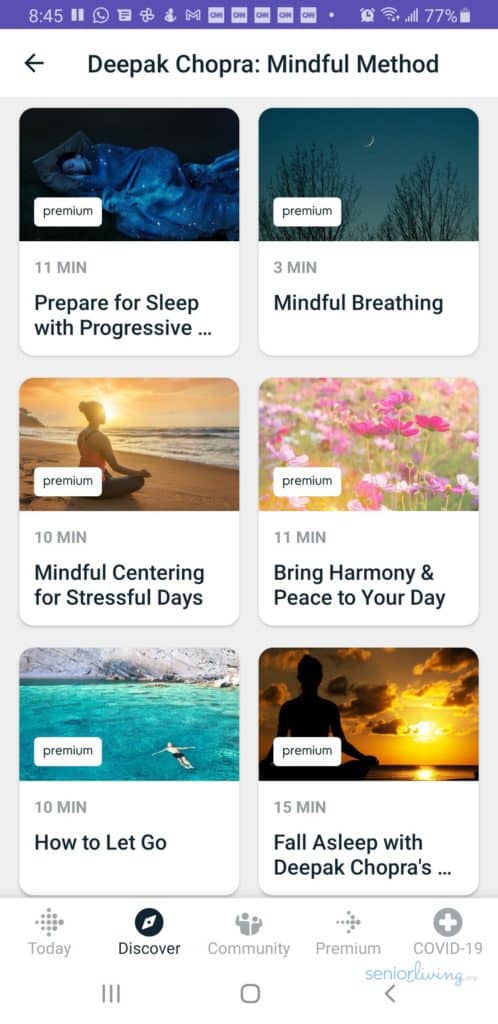
Scrolling through Deepak Chopra's mindfulness and meditation videos in the Fitbit app
Check out my video below to learn how to optimize your health with your Fitbit!
Smartwatch Features
Since Fitbits are worn around the wrist and can display the time, they can easily replace your everyday watch. For those of you who carry a cell phone, some models can replicate the functions of a smartwatch, setting alarms and displaying your texts and emails. Unlike the much-heralded Apple Watch, Fitbits can work in both Android and iOS environments so that they can sync to most smartphones on the market.
Ironically, while I was impressed with how much Fitbits make users want to move, the smartwatch capability I enjoyed most cuts down on moving. Seniors with cell phones may carry them in a purse or a pocket, or they could be across the room when they hear the ding of an incoming message or ring of a call. Is it important or a waste of time? Instead of walking across the room or fumbling to pull your phone from your pocket or purse, you can just glance at your Fitbit, which will tell you the sender or caller. A tap on your watch allows you to see the message and even answer the phone if desired. As someone who receives more than 100 emails a day, wearing a Fitbit makes it so much easier to manage the digital interruptions of life.
Sense also features other apps and can trigger the voice assistants Amazon Alexa and Google Assistant, so you can verbally ask it questions like, “What’s the weather outside?” and see the weather report displayed on the screen.
My Final Thoughts on Fitbit
Overall, I enjoyed the Fitbits and the gamification of data generated from both moving (exercise) and stationary (sleeping and meditation) activities. When it comes to physical activity, as well as mindfulness, your best competition is yourself. (Senior Olympians, please disregard.) Seeing numbers that reflect your activities makes you want to change them for the better. Fitbits provide the data for tracking and offer pathways to achieve success to move those numbers – and you – in the right direction.
Want a closer look at my experience with Fitbit? Check out the video below!
